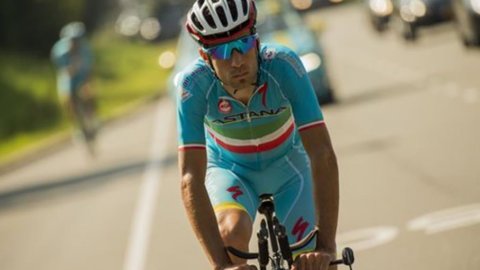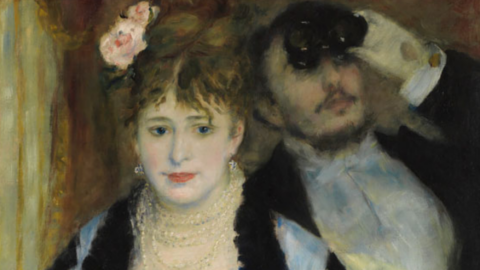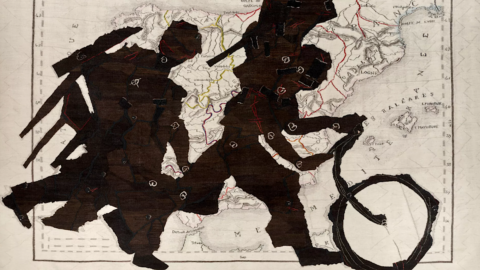Attic programming is realized thanks to the support of Alma Mater Studiorum University of Bologna, the Emilia-Romagna Region and the Municipality of Bologna. By virtue of structural partnership with the DAMSLab, most of the initiatives are scheduled in the spaces of Piazzetta Pier Paolo Pasolini 5/b, plus the Aula Magna of the Santa Cristina Complex (Piazzetta Morandi 2). All initiatives are free admission, while for the performance The Conversion of a Horse (March 13) the compulsory withdrawal of the free coupon is foreseen starting one hour before the start of the event.
Programme:
Thursday February 20
21 hours | DAMSLab/Theater
TALK WITH THE ARTIST: NICOLA SAMORÌ
meeting | By Lucia Corrain
Born in 1977 in Forlì, he studied at the Academy of Fine Arts in Bologna graduating in 2004, Nicola Samorì lives and works in Bagnacavallo and is an established national and international artist. His works are the result of a research on the works of the past, in particular of the XNUMXth and XNUMXth centuries. At first perfectly reproduced, the works of the masters of art history are then modified with tears, skinning of the colour, mutilations, drippings, additions of matter, so much so that sometimes they give the paintings a sculptural dimension. From the dark backdrops, flashes of light emerge that illuminate the dissolution of the forms represented: Nicola Samorì also discovers in this transformation of matter the signs of beauty and wonder.
His works have received prestigious awards: the Morandi prize (2002), the Michetti (2006) and have been exhibited at the Venice Biennale in 2011 and 2015. Among the numerous personal exhibitions, we mention those held in Perth (2003), Cape Town (2004), Bologna, Trento and Fusignano (2005), Bologna and Turin (2008), Milan (2010), Basel, Trento and Berlin (2011), Tübingen and New York (2012), Lissone, Kiel and New York (2014 ); from 17 January 2020 the site specific exhibition at the Archaeological Museum of Naples is open Black Square.
Thursday 5 March
19 pm | DAMSLab/Auditorium
TALK WITH THE ARTIST: FRANCESCO VEZZOLI
meeting | Edited by Francesco Spampinato
Active since the 1s, Francesco Vezzoli is one of the most internationally acclaimed Italian contemporary artists, whose exhibition projects have been created in prestigious museum institutions including the Castello di Rivoli, the MoMA PSXNUMX and the Musée d'Orsay. His production includes videos, installations and a peculiar series of crochet collages, which is accompanied by a growing activity as a curator. Characterized by constant references to the history of art and Italian culture, both classical and vernacular, Vezzoli's works and projects explore the media dimension through which our interpretation of history and present reality is conveyed. In conversation with Francesco Spampinato, the artist will discuss his recurring use of languages and signs typical of the film and television industry, as in the case of videos Non-Love rallies (2004) and Trailer for a Remake of Gore Vidal's Caligula (2005), and references to the culture of entertainment in recent curatorial projectsTV 70 (Prada Foundation, Milan, 2017) e Party politics (Giuliani Foundation, Rome, 2019).
Friday 13 March
21 hours | DAMSLab/Theater
Ludovica Rambelli Theater – Les Tableaux
THE CONVERSION OF A HORSE
Tableaux Vivants by Caravaggio
Performances | Directed by Ludovica Rambelli | Assistant director Dora De Maio | With an introduction by Daniele Benati and Lucia Corrain
It's up to the director theatrical Ludovica Rambelli the recovery of the ancient eighteenth-century technique of tableaux vivants, carried on, after her disappearance, by the Neapolitan company named after her, currently directed by Dora De Maio.
The show-performances – based on the technique of living pictures, born in the eighteenth century – involve composing a picture with flesh-and-blood actors before the eyes of the spectators: this is the case of tableaux vivants inspired by the works of Michelangelo Merisi known as Caravaggio, who will live on the notes of Mozart, Vivaldi, Bach, Sibelius.
A cut of light illuminates and frames the scene and the actors gradually position themselves proposing the canvases of the artist who lived at the end of the 500th century, making his works "alive". Using the clothes and postures of the original paintings, the Caravaggesque "theater" thus comes alive, comes to life, and then returns to the immobility of the actors, to the original silence. In a contained time, the performers, with weighted movements and dressings, stage the works of Caravaggio in this way, setting up the individual paintings in front of the spectators, passing from the dynamic phase of preparation to the static phase of the painting in three dimensions.





